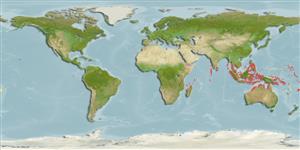>
Ovalentaria/misc (Various families in series Ovalentaria) >
Pomacentridae (Damselfishes) > Pomacentrinae
Etymology: Cheiloprion: Greek, cheilos = lip + Greek, prion = saw (Ref. 45335).
More on author: Day.
Environment: milieu / climate zone / depth range / distribution range
Ecologia
marino associati a barriera corallina; non migratori; distribuzione batimetrica 1 - 3 m (Ref. 9710). Tropical; 15°N - 20°S
Indo-West Pacific: Sri Lanka to the Solomon Islands, north to the Philippines, south to Vanuatu and northern Australia; Palau in Micronesia.
Size / Peso / Age
Maturity: Lm ? range ? - ? cm
Max length : 6.0 cm SL maschio/sesso non determinato; (Ref. 7247)
Spine dorsali (totale): 13; Raggi dorsali molli (totale): 13-14; Spine anali 2; Raggi anali molli: 13 - 14.
Found usually among beds of branching corals in shallow lagoon reefs, singly or in small groups (Ref. 4966). Feed primarily on the polyps of Acropora corals. Diurnal species (Ref. 113699). Oviparous, distinct pairing during breeding (Ref. 205). Eggs are demersal and adhere to the substrate (Ref. 205). Males guard and aerate the eggs (Ref. 205).
Life cycle and mating behavior
Maturità | Riproduzione | Deposizione | Uova | Fecundity | Larve
Oviparous, distinct pairing during breeding (Ref. 205). Eggs are demersal and adhere to the substrate (Ref. 205). Males guard and aerate the eggs (Ref. 205).
Allen, G.R., 1991. Damselfishes of the world. Mergus Publishers, Melle, Germany. 271 p. (Ref. 7247)
IUCN Red List Status (Ref. 130435)
Threat to humans
Harmless
Human uses
Pesca: di nessun interesse
Informazioni ulteriori
BibliografiaAcquacolturaProfilo di acquacolturaVarietàGeneticaElectrophoresesEreditarietàMalattieElaborazioneNutrientsMass conversion
Strumenti
Special reports
Download XML
Fonti Internet
Estimates based on models
Preferred temperature (Ref.
123201): 27.1 - 29.3, mean 28.7 °C (based on 1821 cells).
Phylogenetic diversity index (Ref.
82804): PD
50 = 1.0000 [Uniqueness, from 0.5 = low to 2.0 = high].
Bayesian length-weight: a=0.02344 (0.01149 - 0.04783), b=2.99 (2.82 - 3.16), in cm total length, based on LWR estimates for this (Sub)family-body shape (Ref.
93245).
Trophic level (Ref.
69278): 3.3 ±0.6 se; based on diet studies.
Resilienza (Ref.
120179): Alto, tempo minimo di raddoppiamento della popolazione meno di 15 mesi (Preliminary K or Fecundity.).
Fishing Vulnerability (Ref.
59153): Low vulnerability (10 of 100).
Nutrients (Ref.
124155): Calcium = 180 [88, 307] mg/100g; Iron = 0.899 [0.496, 1.602] mg/100g; Protein = 18.4 [17.2, 19.7] %; Omega3 = 0.108 [0.057, 0.199] g/100g; Selenium = 13.6 [6.7, 29.7] μg/100g; VitaminA = 126 [35, 433] μg/100g; Zinc = 2.07 [1.29, 3.16] mg/100g (wet weight);
